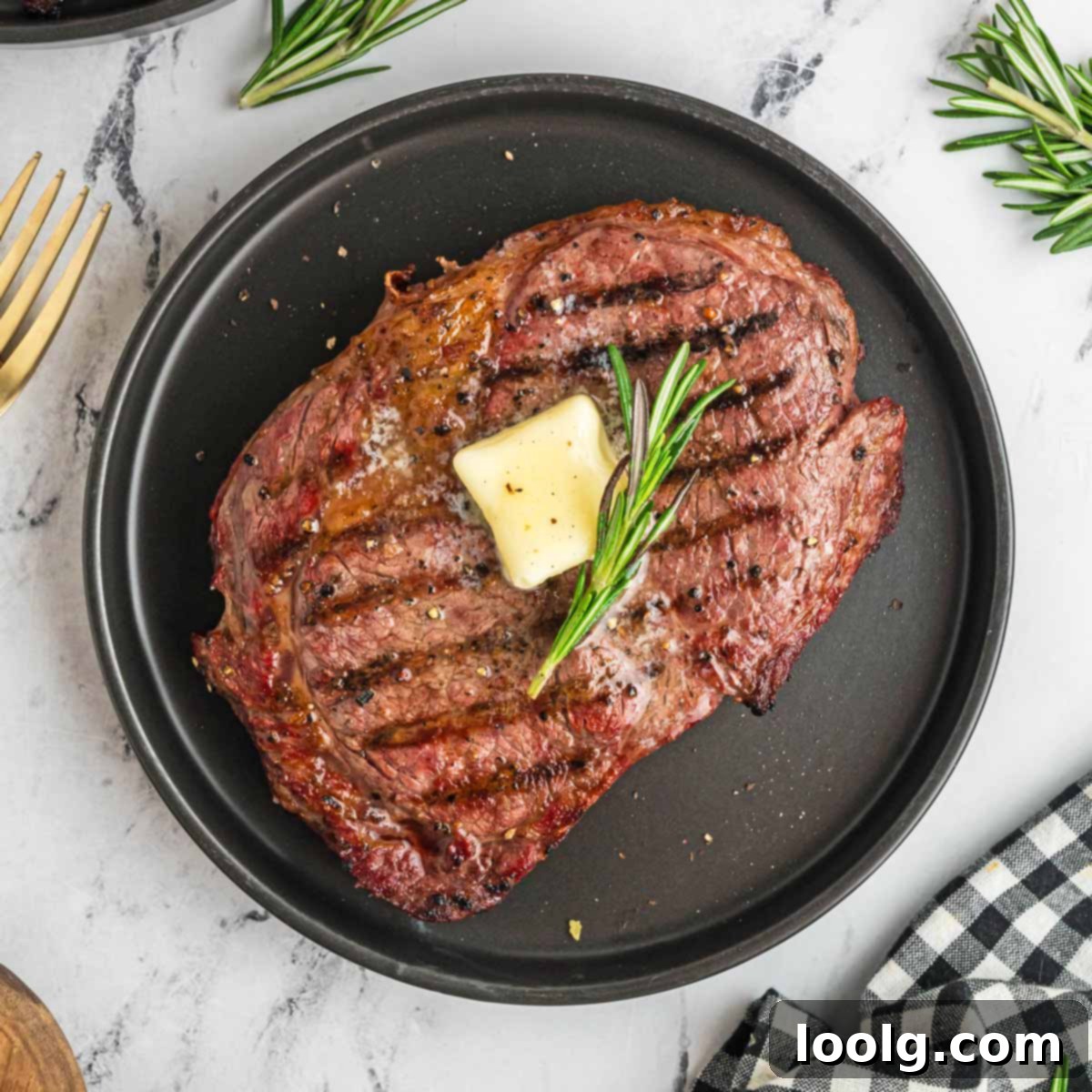The Ultimate Guide to Perfectly Smoked Ribeye Steak: Juicy, Tender, and Unforgettable Flavor
Prepare to tantalize your taste buds with the unparalleled experience of a perfectly smoked ribeye. This method transforms a premium cut of beef into a culinary masterpiece, boasting a rich, smoky depth of flavor that will impress even the most discerning palate. The result is a steak so tender it practically melts in your mouth, infused with a sublime smokiness that is both robust and nuanced. When the seasoning is just right, and the texture is impeccably juicy, you’ve got an irresistible option for any meat lover seeking a truly exceptional meal.
During those scorching days when the thought of heating up the kitchen is unbearable, turning to your smoker is a brilliant solution. Imagine serving a sizzling, succulent smoked ribeye alongside Air Fryer Baked Potatoes and a refreshing Panzanella Salad – all prepared outdoors without breaking a sweat. If the weather permits and you’re inclined to use your stovetop, some perfectly Boiled Broccoli makes an excellent verdant companion to this magnificent steak. This two-stage cooking process—first low and slow smoking, then a high-heat sear—ensures an unbelievably juicy interior with a beautifully crusted exterior, making every bite a celebration of flavor and texture.
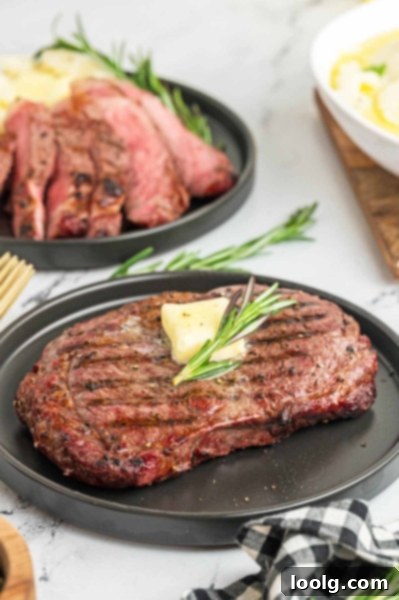
Why Ribeye is the Ideal Steak for Smoking
Choosing ribeye for smoking is a decision rooted in culinary wisdom. Ribeye stands out as a superior cut of meat, renowned for its incredible tenderness and rich flavor, making it absolutely perfect to smoke over low heat. The secret lies in its generous marbling – those intricate streaks of intramuscular fat that weave throughout the muscle. During the slow smoking process, this fat gradually renders and melts, essentially basting the meat from within. This not only imbues the steak with incredible moisture but also amplifies its inherent beefy flavor, resulting in an exceptionally juicy and flavorful experience that distinguishes it from other cuts.
The best smoked steaks are typically crafted from thick cuts that boast a significant amount of fat. This fat is not merely for flavor; it’s a crucial component that contributes to the steak’s tenderness and succulence. As the fat melts during cooking, it transforms the meat into an incredibly supple, mouth-watering delight. Ribeye is widely considered one of the best cuts of beef to utilize if your goal is to achieve this ideal fat content, promising a steak that is rich, deeply flavored, and exquisitely tender with every single bite. Its robust structure also allows it to absorb smoke flavors beautifully without drying out.
Ingredients: Keeping it Simple for Maximum Flavor
One of the beauties of a high-quality ribeye is its inherent deliciousness. The meat itself is so flavorful that it often feels unnecessary to overwhelm it with a multitude of seasonings. For this reason, we advocate a simple approach to seasoning, allowing the natural beef flavor and the exquisite smoky notes to truly shine. A judicious application of salt and pepper, perhaps a touch of olive oil, is often all that’s needed to enhance rather than mask the steak’s character.
However, if you have a cherished homemade spice rub or a favorite commercial blend that you adore, don’t hesitate to use it! Smoking a ribeye is also an excellent opportunity to experiment with different flavor profiles. Whether you opt for a minimalist approach or a more complex rub, the key is to ensure it complements the steak and the wood smoke, rather than overpowering it. Remember, the quality of the ribeye itself is your primary ingredient, so let its natural goodness be the star of the show.
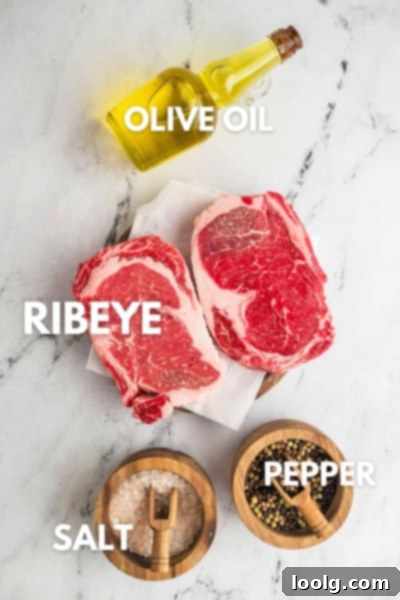
What Exactly is a Ribeye?
To truly appreciate the smoked ribeye, it helps to understand what this celebrated cut entails. Ribeye steak is a high-quality cut of meat sourced from the beef rib primal cut, specifically from the rib cage area of the cow. This region is known for producing incredibly tender meat because it’s a muscle that the cow does not exercise vigorously. The lack of heavy muscle activity means the fibers remain fine and delicate, contributing significantly to its renowned tenderness.
It’s important to distinguish ribeye from prime rib, as they are both cut from the same part of the cow but handled differently. Prime rib typically refers to a larger, bone-in roast that is cooked slowly and often served as a magnificent centerpiece. In contrast, ribeye is generally boneless (though bone-in ribeyes, often called cowboy steaks, exist and are fantastic for smoking) and is cut into individual steaks, designed to be cooked and served as single portions. This distinction in preparation and presentation allows the boneless ribeye to be cooked more directly like other individual cuts of steak, making it versatile for grilling, pan-searing, and, of course, smoking.
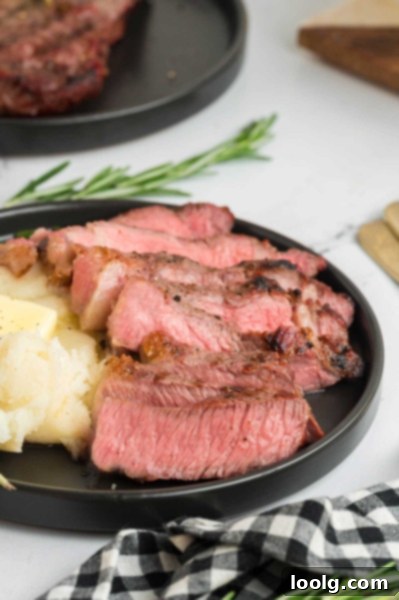
The Art of Smoking a Ribeye: A Step-by-Step Guide
Smoking a ribeye is an art form that elevates an already delicious cut of meat by infusing it with an unmistakable depth of flavor. The process, while requiring patience, is straightforward and immensely rewarding. Achieving that perfect balance of smoky flavor, tenderness, and a beautiful crust relies on precise preparation and temperature management. Here’s how to master it:
Initial Preparation: Dry Brining for Optimal Juiciness and Flavor
The first crucial step in smoking a ribeye is proper seasoning, specifically dry brining with salt. To begin, generously rub your steak with coarse sea salt. This isn’t just about flavor; it’s a critical technique for moisture retention and tenderization. Allow the steak to dry brine for at least 40 minutes at room temperature. During this time, the salt draws moisture to the surface, dissolves, and then reabsorbs into the meat, breaking down muscle fibers and seasoning the steak from within. This process is vital for a truly juicy outcome. If you find yourself short on time and cannot apply the seasoning at least 40 minutes before cooking, it’s best to put the seasoning on immediately before placing it on the smoker. The “immediately before” strategy prevents moisture loss that can occur if the salt sits on the surface for a short, insufficient period.
For even deeper flavor penetration and tenderness, you can apply the seasoning up to 24 hours in advance. If you choose this extended brining method, make sure to refrigerate the steak uncovered. This allows air to circulate, promoting a drier surface which is essential for developing a good crust later. If you’ve refrigerated your seasoned ribeye, remember to let it sit at room temperature for approximately 1 hour before cooking. This helps the steak cook more evenly from edge to center, preventing a cold core.
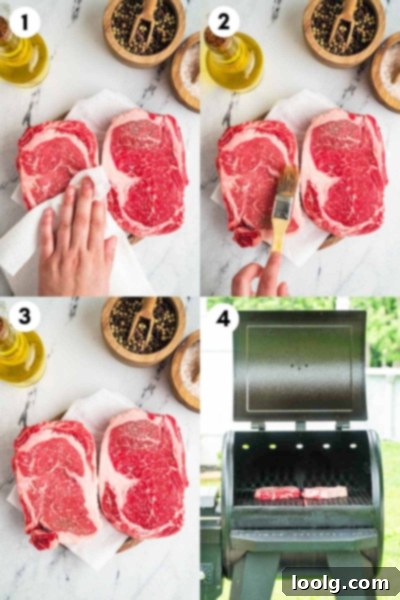
The Smoking Phase: Low and Slow for Flavor Infusion
Once your steak is properly prepped and has come to room temperature, it’s time for the smoker. Set your smoker to a consistent temperature of 225 °F (107 °C) for indirect cooking. The goal during this phase is to slowly bring the steak’s internal temperature up while infusing it with rich, smoky flavor. Smoke the ribeye until it reaches an internal reading of 110 °F (43 °C). This initial stage typically takes anywhere between 20 to 50 minutes, but it’s crucial to understand that cooking time varies significantly based on the thickness of your meat, its initial temperature, and even external factors like ambient temperature and humidity. Always rely on an accurate meat thermometer, not the clock, to determine doneness.
The Reverse Sear: Achieving the Perfect Crust
After the initial low-and-slow smoke, remove the ribeye from the smoker and loosely tent it in aluminum foil. This resting period, while the smoker heats up, helps to lock in juices. Next, dramatically increase your smoker’s temperature to a blazing 475 °F (246 °C). This high heat is essential for the “reverse sear” technique, which creates that desirable, deeply caramelized crust without overcooking the interior.
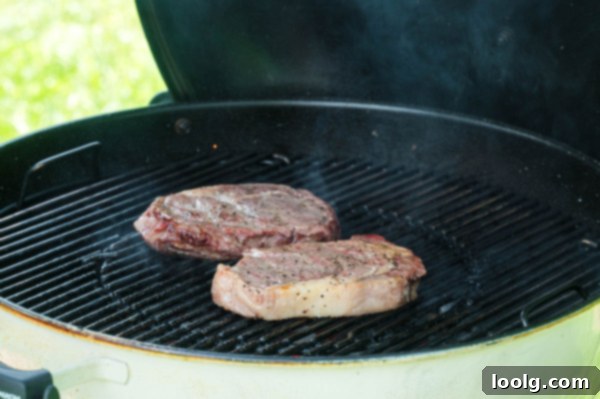
Once your smoker reaches the target searing temperature, place the tented ribeye back into the smoker, directly over the grates, to sear. Continue cooking until you achieve an internal temperature of 130 °F (55 °C) for a perfect medium-rare. Keep a close eye on it, as this high-heat stage is quick. While your steak is achieving its glorious crust, consider preparing some homemade Onion Ring Chips – they look amazing and offer a fantastic crunchy contrast to the tender steak. Finally, and this is critical, when the steak has reached its target temperature, let it rest for a full 5 to 10 minutes before slicing. This resting period allows the juices to redistribute throughout the meat, preventing them from running out when you cut into it, ensuring every slice is incredibly juicy and tender.
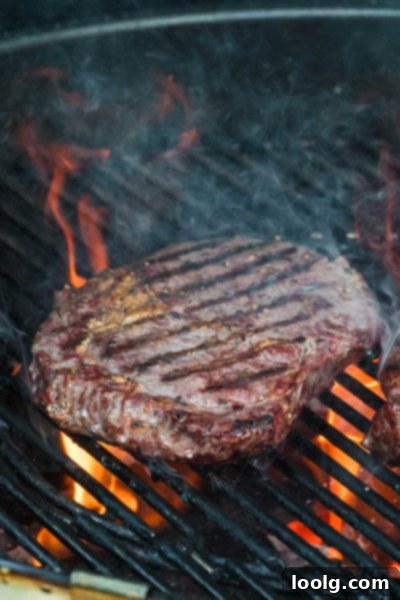
How Long Does It Take to Smoke a Ribeye? Mastering Doneness by Temperature
The duration it takes to smoke a ribeye is less about a fixed number of minutes and more about achieving precise internal temperatures. While many prefer their ribeye no further than medium-rare to truly appreciate its tenderness and flavor, you absolutely have the flexibility to cook it to medium or even medium-well if that’s your preference. The golden rule for perfectly cooked steak is always to cook by temperature, not by time, as factors like steak thickness, initial temperature, and even ambient smoker temperature can greatly affect cooking speed. 😉
Here are the crucial internal temperatures to guide your ribeye to your desired level of doneness. Remember that these are the temperatures *before* resting, as the steak will continue to cook a few degrees more due to carryover heat:
- Rare — 125 °F (52 °C): A cool red center, very tender.
- Medium-Rare — 135 °F (57 °C): A warm red center, tender and juicy – often considered the ideal for ribeye.
- Medium — 145 °F (63 °C): A warm pink center, slightly firmer but still very juicy.
- Medium-Well — 155 °F (68 °C): A slightly pink center, firm texture.
- Well — 160 °F (71 °C): Little to no pink, firm texture.
To ensure you hit your mark precisely, remove the ribeye from the heat approximately 5 minutes before it reaches your desired final internal temperature. This accounts for “carryover cooking,” where the steak’s internal temperature continues to rise during the resting period. Allowing it to rest is not just a suggestion; it’s a vital step to ensure the juices redistribute evenly throughout the meat, resulting in a significantly more tender and succulent steak experience.
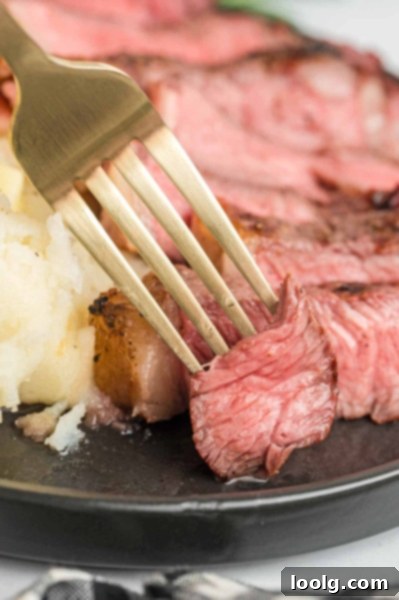
Why Use a Smoker for Ribeye? Unlocking Unbeatable Flavor and Tenderness
Smoking is a time-honored culinary technique that involves cooking meat slowly in an enclosed space over low heat, generated by burning wood. This extended cooking duration allows the meat to not only cook thoroughly but, more importantly, to slowly absorb the complex and aromatic flavors of the wood smoke. When applied to a cut like ribeye, smoking offers a trifecta of advantages that transform an already great steak into an extraordinary one:
- **Enhanced Tenderness:** The low and slow cooking environment of a smoker is incredibly effective at breaking down the tough collagen fibers within the meat. This breakdown process contributes significantly to making the ribeye exceptionally tender, almost melting in your mouth, a texture that is difficult to achieve with high-heat cooking alone.
- **Unparalleled Flavor Infusion:** The primary advantage of smoking is the unique flavor it imparts. As the wood slowly smolders, it releases compounds that penetrate the meat, creating a distinct, rich, and often complex smoky profile that simply cannot be replicated by other cooking methods. Different wood types offer varied flavor notes, allowing for a personalized culinary experience.
- **Juicy Perfection:** The beautiful marbling of a ribeye, combined with the gentle heat of the smoker, allows the intramuscular fat to slowly render. This melting fat continually bastes the meat, locking in moisture and ensuring that the tenderized meat remains incredibly juicy. When this succulent, tender meat meets the bold flavors of the smoke, the result is a truly amazing, melt-in-your-mouth bite every single time.
If you’re looking for more ways to utilize your smoker and explore the incredible versatility of this cooking method, I have several other fantastic recipes. You might enjoy these hearty Smoked Burgers, the incredibly flavorful Smoked Corned Beef Brisket, or the wonderfully tender Smoked Chicken Quarters. All are excellent options for maximizing the potential of your smoker and expanding your repertoire of smoked delicacies.
And if you find yourself without a smoker but still crave a delicious ribeye, don’t despair! This Air Fryer Ribeye offers a convenient and surprisingly satisfying alternative for a quick and tasty steak.
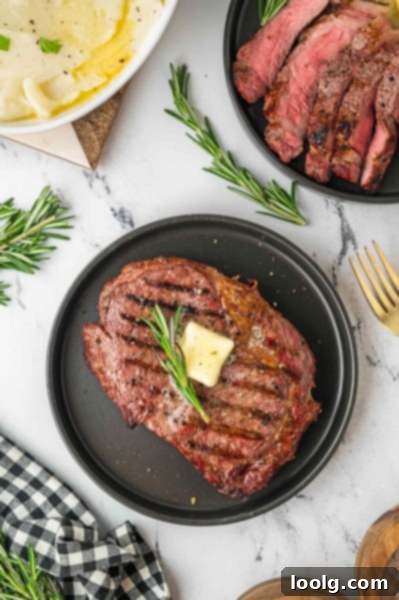
Choosing the Right Wood for Smoking Your Ribeye
The type of wood you choose for smoking your ribeye plays a significant role in the final flavor profile of your steak. Each wood imparts a unique aromatic essence, ranging from mild and fruity to strong and robust. For smoking ribeye, several types of wood are highly recommended for their complementary flavors:
- Oak: A classic choice, oak offers a medium-strong smoke flavor that pairs beautifully with beef without overpowering it.
- Hickory: Known for its strong, bacon-like flavor, hickory is a favorite for red meats and provides a very distinctive smoke.
- Mesquite: This wood delivers a very intense, earthy, and bold flavor, best used in moderation or for those who love a powerful smoke presence.
- Apple: A milder, sweeter, and fruity smoke that subtly enhances the beef, perfect for a less aggressive smoky taste.
- Pecan: Similar to hickory but a bit milder and nuttier, pecan wood provides a rich, sweet, and buttery flavor.
- Cherry: Offers a mild, sweet, and fruity smoke that also imparts a beautiful dark red color to the meat.
- Peach or Pear: These fruitwoods provide a very light, sweet, and delicate smoke, ideal for a subtle infusion of flavor.
Don’t be afraid to experiment with different wood types or even create your own blends to discover what you enjoy most. If you venture into trying something unique, I’d absolutely love to hear how it goes and what delicious flavors you uncover!
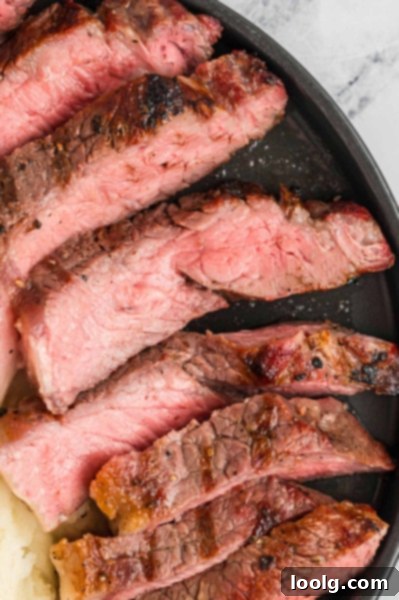
Cool Side Dishes to Complement Your Smoked Ribeye
A magnificent smoked ribeye deserves equally impressive accompaniments. Pairing your steak with fresh, vibrant side dishes can elevate the entire meal, offering a delightful contrast to the rich, smoky flavors of the beef. Here are some cool, refreshing options that perfectly complement the star of your plate:
- Italian Tomato Salad: A simple yet elegant salad featuring ripe tomatoes, fresh basil, and a light vinaigrette. Its bright acidity and freshness cut through the richness of the ribeye beautifully.
- Polish Cucumber Salad: Creamy, tangy, and incredibly refreshing, this cucumber salad offers a cool counterpoint to the warm steak, providing a lovely textural and flavor balance.
- Sunflower Seed Salad with Cranberries: A unique salad combining the crunch of sunflower seeds with the sweet-tartness of cranberries, along with fresh greens. It adds texture, sweetness, and a touch of tartness that brightens the meal.
That’s everything you need to know to create an unforgettable smoked ribeye experience! I truly hope you’ll enjoy perfecting and savoring this incredible recipe. If you decide to make it, please take a moment to comment below and share how it turned out. I’d love to hear about your culinary adventure! Thanks for reading and happy smoking! 🙂
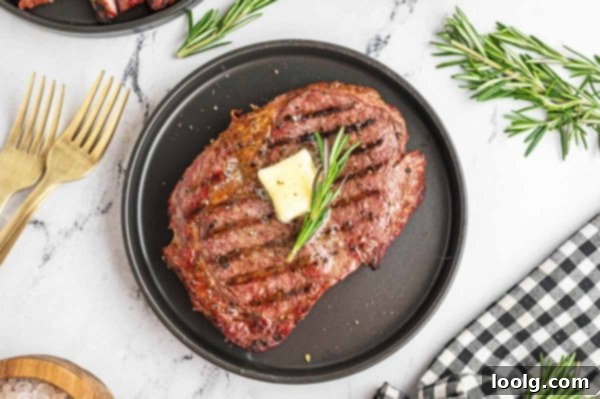
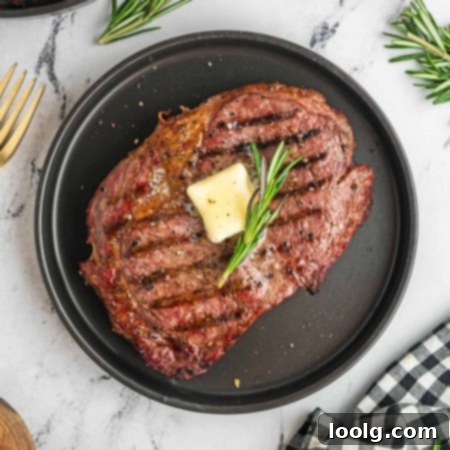
Smoked Ribeye Recipe
Ingredients
- 2 ribeye steaks about 1.5″ and 12oz each (or as close as you can get), boneless
- 1 tablespoon coarse sea salt divided
- 2 teaspoons olive oil
- Black pepper
Instructions
-
If you can’t rub on the seasoning at least 40 minutes before cooking, put on the seasoning immediately before cooking. You can also put on the seasoning up to 24 hours in advance. If doing that, refrigerate it uncovered.
-
Prepare your smoker for indirect cooking according to smoker instructions, using oak, hickory, apple, pecan, cherry, peach or pear wood. Set it to 225 °F (107 °C).
-
Rub a teaspoon of salt on each steak, rubbing both the top and bottom.
-
Pat dry with a paper towel, brush on olive oil, and sprinkle on the remaining teaspoon of salt (so ½ tsp per steak), and also pepper the steak.
-
Place on the prepared smoker and smoke for 20-50 minutes or until the internal temp is 110 °F (43 °C). It’s important to cook to temperature and not time. The time varies so widely based on a number of factors.
-
Remove the steaks from the smoker and tent with foil. Place the grill grates on the smoker and increase the temperature to 475 °F (246 °C). This will likely take around 10 minutes. So your steaks will be tented for about 10 minutes.
-
Once it’s come to temperature, place the steaks on the grill grates and cook another 4-10 minutes per side or until it reaches 130 °F (54 °C).
-
Remove the steaks from the smoker and let them rest for 10 minutes before slicing (this is so all the juice doesn’t run out when slicing). After the rest, the internal temperature (for medium-rare) should now be 135 °F (57 °C).
-
Serve! If you have any left over, let cool completely and refrigerate in an airtight container for up to 3 days.
Notes
